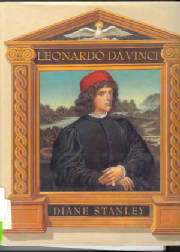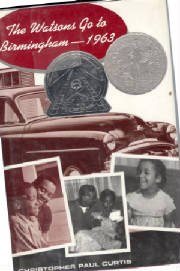 |
||
|
Karen's Book Reviews |
||
| | Home | Picture Books | Traditional Literature | Poetry | Nonfiction | Historical Fiction/Biography | Fiction, Fantasy, and Young Adult Literature | Author Study - S. E. Hinton | Censorship Project | |
|
Historical Fiction/Biography
|
|
|
|
||||||||||||
|
Curtis, Christopher Paul. 1995. The
Watsons go to Ten year old Kenny has problems at home and at school.
He experiences the prejudices that others have for those that see others with imperfections. He is picked on at school and
at home by his older brother. The family decides to take a vacation to The reader sympathizes with Kenny because he tends
to run into problems everywhere that he turns. He learns to cope with the lazy eye that he has no matter how others treat
him. This book takes a slow pace in the beginning but picks up when the family begins their trip across the country. Some
of the things that take place in the car along the way make the reader reminisce about such trips. The near tragedy that Kenny
faces and the tragedy that he sees take place makes the reader's heart ache for him. In the end, the family draws closer because
of the tragedies and the reader rejoices with them.  Leonardo
da Vinci was born an illegitimate child. Therefore, he was often shunned by society. His mother later married and he
went to live with his father. He found a friend in his uncle, Francesco. They later spent much time together. Society would
never allow him to become a doctor, pharmacist, or banker, and because of this, his father thought education would be wasted
on Leonardo. Since he
had a talent for drawing, he was apprenticed to Verrochio. Leonardo not only became an artist, he also was a noted musician.
He dissected animals and humans in order to draw them correctly. He also invented many items. Some of the items include: post
hole diggers, a door that closed automatically, a submarine, pliers, and a self-closing toilet lid. He invented weapons that
led to modern equipment for World War I. He drew plans for a flying machine much like a helicopter. Two of his
most famous paintings are the Mona Lisa and The Last Supper. No one
knows for sure who modeled for the potrait. Leonardo kept notebooks of sketches and notes. Because he never married,
when he died the notebooks went to Francesco Melzi, a pupil of Leonardo's, who tried to organize them. At Melzi's death, the
notes were given to his son who did not value them. He sold them or gave them away. The result of Melzi's work was never published
until 1651, and some of the notes were missing. Some notes of Leonardo have shown up as late as 1965. This book
is an Orbus Pictus 1997 Award winner. The reader is drawn into Leonardo's life because he was not only a painter as everyone
would think, but also an inventor. The various things that he was credited for inventing would make one wonder. This
man was much more intelligent than the reader would have thought. The vivid illustrations add to the story depicting
the life and times of Leonardo da Vinci. Because he was an illegitimate child, he was not accepted well in society, and he
died not ever having had a wife and children which leaves the reader feeling very sympathetic with him. He was a very interesting
man. |
|||||||||||||


